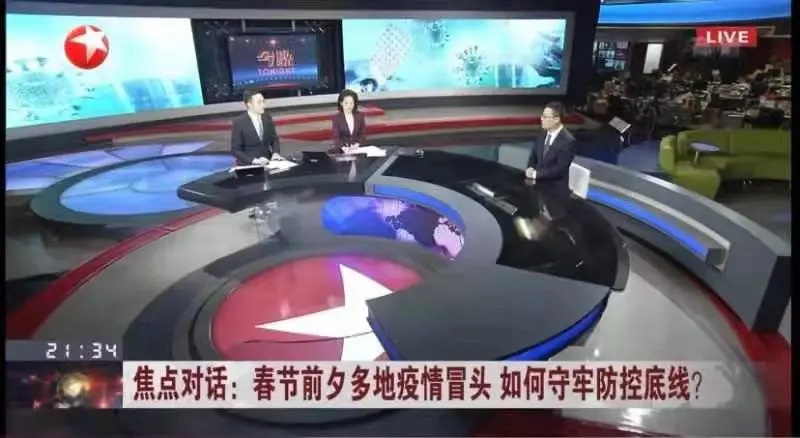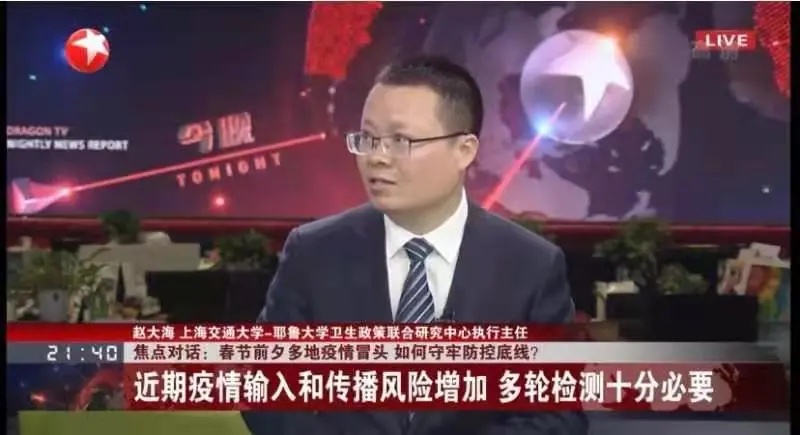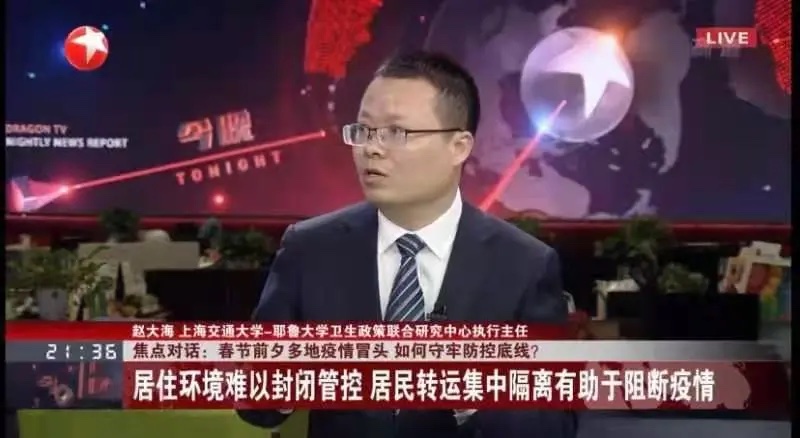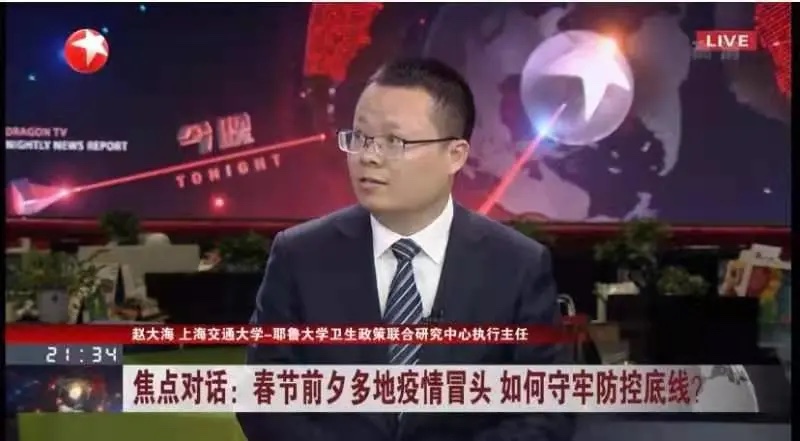上海交大赵大海做客东方卫视:减少人口流动是春运疫情防控的最重要举措

上海交通大学-耶鲁大学卫生政策联合研究中心执行主任、上海交通大学国际与公共事务学院博士生导师赵大海,自新冠肺炎疫情暴发以来,对于新冠疫情暴发、防控以及卫生政策第28次接受上海电视台专访,也是第78次接受央视、上视专访。2021年1月21日,赵大海做客东方卫视演播室,在《今晚》节目就上海新增本土新冠病例、全国新冠疫情等相关话题进行了直播访谈。现将访谈内容摘录如下。

主持人:我们在上海演播室,邀请到了上海交通大学-耶鲁大学卫生政策联合研究中心执行主任赵大海。有几个大家比较关注的问题请教一下您,首先就是上海,这次新增的病例是涉及两家医院的,而且是通过主动筛查发现,所以很多公众在担心,那有没有可能接下来会有一个病例逐渐上升的,或者是院内感染的这样一个趋势?
赵大海:首先我认为有这种可能性,确实有我们现在还没有发现的新病例的可能。与此同时,我们在这两家医院全部进行了闭环的管理,所有医务人员以及所有现在正在住院的患者及其家属,全部要进行核酸检测,也就是说我们已经采取了相应的非常严格的措施,尽可能避免疫情的进一步的扩散,包括院内感染。

主持人:在今天下午的新闻发布会上,这也是很多老百姓在关注的,也提到了,应该说给大家吃了一个定心丸,就是未来几周之内,上海的疫情是可以控制的住的,您能给我们解释一下这个控制的过程大概是怎么样?您怎么看?另外呢,就是说在这个过程当中,可能当下最重要的是什么?我们老百姓应该注意些什么?
赵大海:好的。我们现在所做的工作,包括我们疫情防控的核心环节,主要是三个方面。第一,是对于涉事的小区进进行了非常严格的管理,由于该小区不太方便进行封闭管理,我们将对小区居民全部转运到指定的隔离点进行集中隔离,这是一个非常重要的环节,也是我们当下非常重要的一项工作;第二,我们同时进行对医院闭环式管理,对全部相关人员进行核酸检测。另外,还有一项工作也是在同步开展的,就是对于现在所确诊的三例患者的所有密切接触者,全部已经找到,而且正在进行包括核酸检测在内的检查。如果密切接触者已经完全掌控住了,最理想的状态,即如果这些密切接触者核酸检测全是阴性的,那我们很快就控制住疫情;即便有阳性的,我们也有很完备的方案,公众完全没有必要过度恐慌。

主持人:我们接下来继续请教赵大海。您看像山东平度这个例子,他是第三次核酸检测的时候才检测出是阳性的,这样的案例您怎么看?因为很多人看了会觉得第三次检测才检测出来,那会不会风险很大,他是一个个案呢,还是说是其他什么?另外就是针对这样的个案,一般我们的处理程序是怎么样?给我们介绍一下。
赵大海:好的。像这种三次才检测出阳性的案例,首先不是特别多,但也不是个案。在我们前期做核酸检测的过程当中也碰到过,可能超过了三次才检测出阳性的患者的也发现过,对于这种情况而言,确实对我们整个疫情防控带来了很大的挑战。我们常规的做法,要看他是不是患者的密切接触者,如果是患者的密切接触者,我们一般本身也是做几次核酸检测,也不是做完一次核酸检测就放掉的。另外,我们通常还借助于其他的一些检查方式,比如说临床医生根据临床的一些判断,包括CT等辅助检查来进行判断,努力做到不让未来可能会是阳性的患者放到社会人群当中去。
主持人:另外,这次山东平度的案例也涉及到一个关键词,就是返乡人员。这两个人都是从黑龙江回来的,所以现在我们也看到国家在推出一些返乡人员的核酸检测的政策措施,但很多人会觉得这是不是一种倒逼,就是不希望你太多频繁的去返乡的出现,那么您怎么看这样的一种措施?另外就是马上要过年了,老百姓想平平安安的过一个年的话,你有什么样的建议?
赵大海:现在国家卫健委出台的对于返乡人员必须要提供七天以内的核酸检测的政策,最主要的目的还是来保证在春运期间,中国不发生比较大的疫情暴发,这个是国家卫健委考量的出发点。它确实在客观上可能会让一部分在犹豫是返乡还是不返乡的人,可能就选择不返乡了,可能确实起到一定的作用。但它的初衷其实只有一个,防范我们国家在春运期间的疫情有比较大的反复。对于春运期间预防的措施,其实最主要还是减少不必要的流动,尽可能响应国家所提倡的留在工作地、学习地来过春节,然后进行一些常规的疫情防控的措施,比如说外出要戴口罩,勤洗手等。
供稿者:上海交通大学
日期:2021年1月22日
Dahai ZHAO’s Exclusive Interview with ShanghaiTV: The most effective control measure involves reducing travel over the Lunar New Year and its associated risk
Dahai Zhao, a doctoral supervisor at the School of International and Public Affairs of Shanghai Jiao Tong University and Executive Director of Shanghai Jiao Tong University-Yale University Joint Research Center for Health Policy, has been interviewed by ShanghaiTV for the 28nd time (the 78nd time by CGTN / ShanghaiTV) since the COVID-19 pandemic. On January 21, 2021, Zhao commented on the new locally acquired cases of COVID-19 in Shanghai and the epidemic situation of infectious diseases in China on “Tonight” of ShanghaiTV.
Anchor: In the Shanghai studio, we're joined by Zhao Dahai, executive director of SJTU-YALE Joint Center for Health Policy. I would like to ask you a few questions that people are concerned about. The first one is Shanghai. The new cases involved two hospitals and were detected through active screening. So a lot of the public is worried, is it possible that there's going to be a gradual rise in cases, or a trend toward hospital-acquired infection?
ZHAO: First of all I think there is the possibility, that is, there is indeed the possibility of new cases that we haven't found yet. At the same time, we have all closed loop management in these two hospitals, and all the medical staff and all the patients and their families who are in the hospital now all have nucleic acid testing. We have taken appropriate and very strict measures to avoid further spread of the outbreak, including the hospital-acquired infection.
Anchor: At the press conference this afternoon, we have reassured everyone that the epidemic in Shanghai can be brought under control in the next few weeks. This is also the concern of many people. Could you give us a general idea of the process of control? What do you think? What else is probably the most important thing in this process right now? What should we pay attention to?
ZHAO: What we are doing now, including the core links of epidemic prevention and control, is mainly in three aspects. First, we have carried out strict management on the involved community. Since it is not convenient for the community to be closed, we will transfer all the residents of the community to the designated isolation point for centralized isolation. This is a very important link and also a very important work for us at present. Second, we conducted closed-loop management of the hospital at the same time and conducted nucleic acid tests on all relevant personnel. And there's another thing that's going on in parallel. All close contacts of the three confirmed cases so far have been found, and nucleic acid tests are being carried out on them. If the close contacts are fully under control, ideally, if these close contacts are all nucleic acid negative, then we can quickly bring the epidemic under control. Even if there are positive ones, we have a very comprehensive program and there is no need for the public to panic undue.
Anchor: We will continue to consult Zhao Dahai. Take the case in Shandong Pingdu for example, he is the third nucleic acid test when the detection is positive, such a case how do you see? He was only found to be positive in his third nucleic acid test, what do you think of such cases? Because a lot of people thought it was the third time he tested positive, and that would be a very risky case for epidemic control. Is he an isolated case, or is it something else? In addition, in view of such cases, what is our general processing procedure? Tell us about it.
ZHAO: Such three tests before finding positive, first of all, is not particularly numerous, but also not isolated. We also encountered in the process of nucleic acid detection in the early stage. Patients who have tested positive more than three times have also been found. In this case, it really poses a big challenge to the prevention and control of the epidemic. Our usual practice is to see if he is a close contact of the patient. If he is a close contact of the patient, we usually do a few nucleic acid tests. In this case, the original approach is not based on a single nucleic acid test to make a clinical diagnosis. In addition, we often rely on other methods of testing, such as clinical judgment, including auxiliary tests such as CT, to try to keep patients who might be positive in the future from from going back into the community.
Anchor: In addition, the case of Pingdu in Shandong also involves a key word, that is, Festival Migrations. Both men had come back from Heilongjiang. So now we also see that the country is rolling out some policy measures of nucleic acid testing for festival migrations. But many people will feel is that a kind of reversed transmission of the pressure? That is, do not want you to return home too often. So what do you think of such a measure? In addition, this is the upcoming Chinese New Year. What advice do you have for the common people if they want to live a safe and sound year?
ZHAO: Now the National Health Commission has issued a policy that people returning home must provide nucleic acid tests within seven days, the main purpose is to ensure that during the Spring Festival travel rush, China does not have a relatively large outbreak. This is the starting point of the National Health Commission's consideration. Objectively, it may make some people who are hesitating whether to return home or not return home choose not to return home, which may indeed play a certain role. But its original intention is actually only one, to prevent our country from a relatively large recurrence during the Spring Festival. In fact, the most important prevention measures during the Spring Festival travel is to reduce unnecessary flow. As far as possible to respond to the national advocate to stay in the work, study city, to celebrate the Spring Festival. Then take some routine measures to prevent and control the epidemic, such as wearing masks and washing hands frequently.
Contributor: SIPA, SJTU
Data: January 22, 2021

